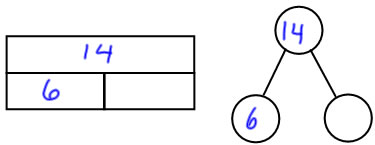14 is the whole and 6 is one part, so we can think: 6+what is 14?

6+8 =14, so the missing part is 8.
Practice:
Think addition and fact families questions
1. Explain how to use think addition using a part-whole diagram or math mountain to figure out 14-6=__
14 is the whole and 6 is one part, so we can think: 6+what is 14?
6+8 =14, so the missing part is 8.
2. Write the missing number fact family for 12-7=___
12-7=__
12-__=7
7+__=12
__+7=12
3. Write the fact family for 12-8=4
12-8=4
12-4=8
4+8=12
8+4=12
4. Draw an open number line diagram that would show the think addition strategy for 14-9=
5. Explain two reasons why think addition is a good strategy for subtraction.
because we can use the addition facts we know
because there are a bunch of subtraction facts that are hard to figure out without using addition
Basic facts drill questions
6. Describe two of Rathmell's recommendations for drill exercises on the math basic facts.
Any two of:
- delay drill until children have efficient strategies to practice
- drill facts in clusters that can be solved using a (known) efficient strategy
- practice for a few minutes each day
- introduce a few facts at a time (10-15)
- practice the same facts for about 2 weeks before moving on
7. Write a cluster of 10 problems for the "use doubles to add" strategy
7+8 6+5 9+7 7+6 8+6 5+7 8+9 5+4 6+4 8+7 (note that it's OK to repeat the same fact: 7+8 and 8+7, but repeated facts should ususally be kept spaced out from each other, unless what you're practicing is the commutative property)
Review of strategies questions
8. What does it mean when we say that addition is commutative?
it means you can put the addends in either order and you still get the same sum: a+b=b+a
9. For each of these strategies, choose a math fact for which it is an efficient strategy, and show how to use the strategy to compute the fact:
a. count on to add
to find 8+3, count: 8....9, 10, 11 (answer is 11)
b. count back to subtract
to find 8-2, count 8... 7, 6 (answer is 6) or count 8, 7... the answer is 6
c. count up to subtract
to find 8-6. count 6...7, 8 (putting up 2 fingers), the answer is 2.
d. use doubles to add
6+8:
6+6=12
8 is 2 more than 6
12+2=14. The answer is 14
e. make ten to add
9+4:
9+1=10
4=1+3
10+3=13. The answer is 13f. build up through ten to subtract
15 - 9
9+1=10
10+5=15
1+5=6. The answer is 6g. back down through ten to subtract
15-7
15-5=10
7-5=2
10-2=8. The answer is 8
10. For each of the math facts problems on the left, tell all of the strategies on the right that would be efficient ways to compute it.
A. 7+8 c, d B. 6+9 d C. 2+7 a D. 3+9 a, d E. 14-8 f, h F. 9-7 c, h G. 6-2 b, h H. 14-6 g, h |
a. count on to add b. count back to subtract c. count up to subtract d. use doubles to add e. make ten to add f. build up through ten to subtract g. back down through ten to subtract h. think addition to subtract |
11. Describe the set of facts for which each of these strategies is efficient:
a. count on to add
sums where one of the addends is 1, 2 or 3
b. count back to subtract
differences where the subtrahend is 1 or 2
c. count up to subtract
differences where the minuend and the subtrahend are close (1 or 2 apart)
d. use doubles to add
sums where the addends are close (1 or 2 apart)
e. make ten to add
sums where one addend is 8 or 9
f. build up through ten to subtract
differences where the subtrahend is 8 or 9
g. back down through ten to subtract
differences where the subtrahend is 1 or 2 more than the ones digit of the minuend